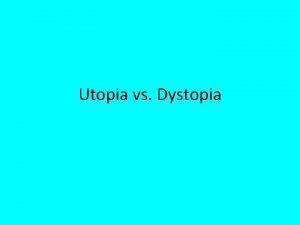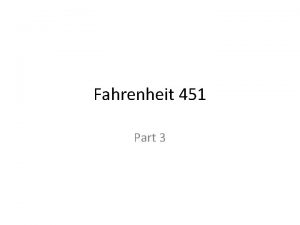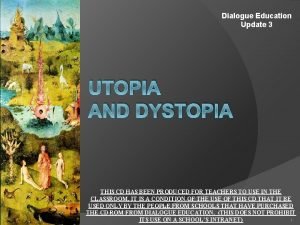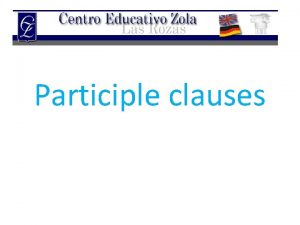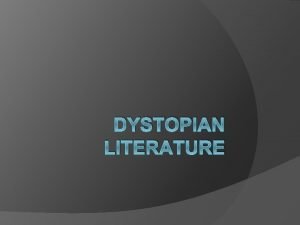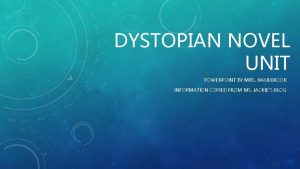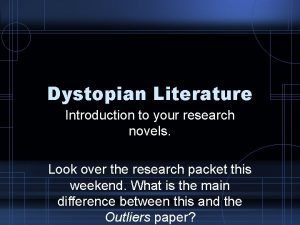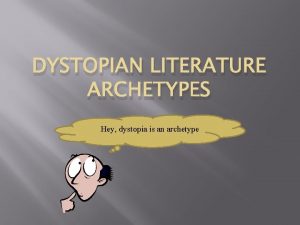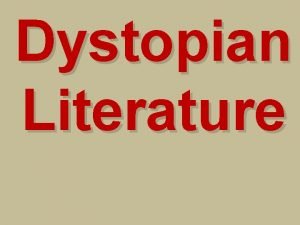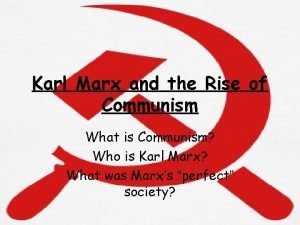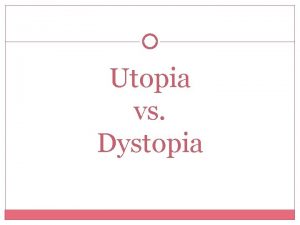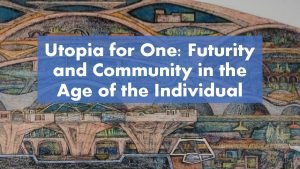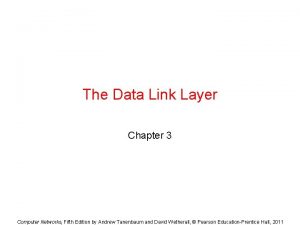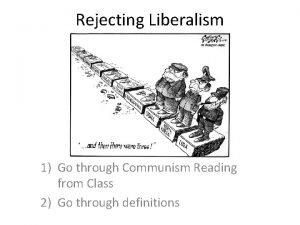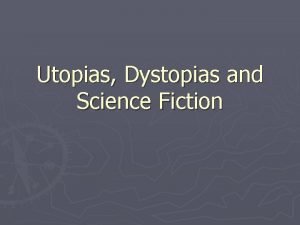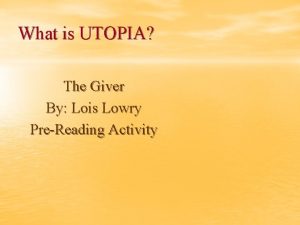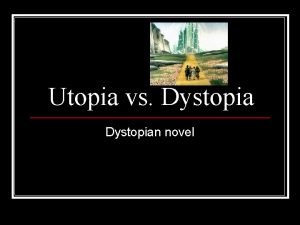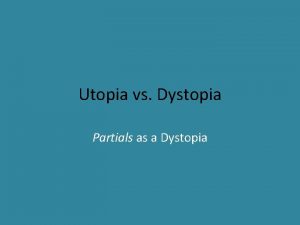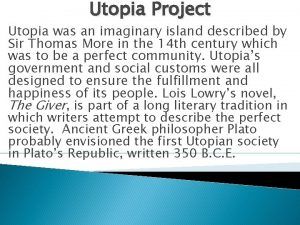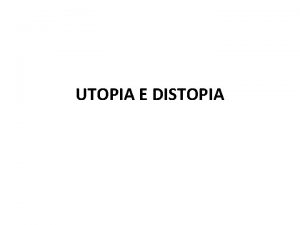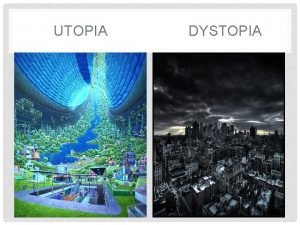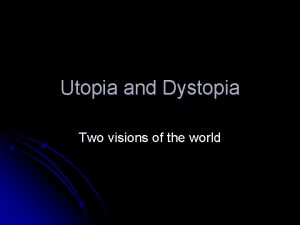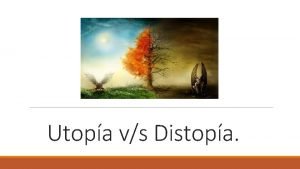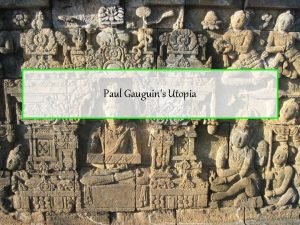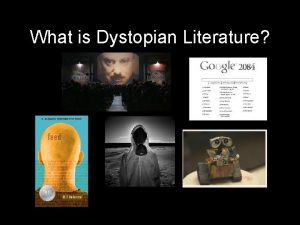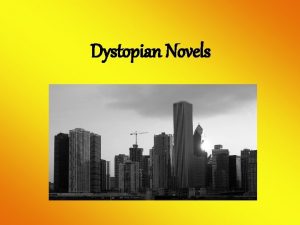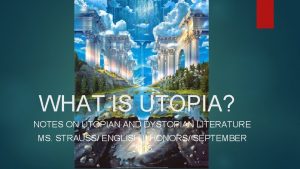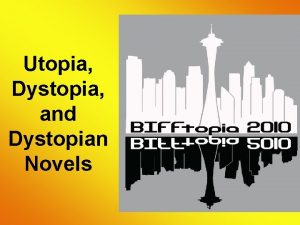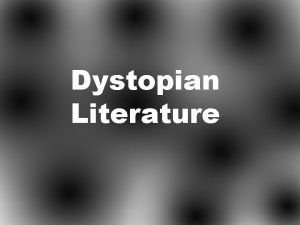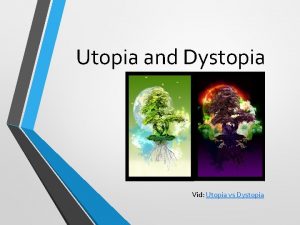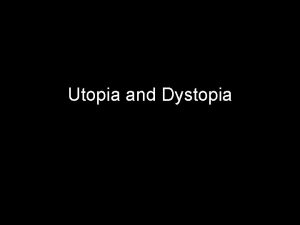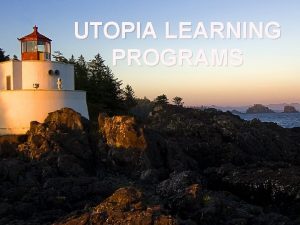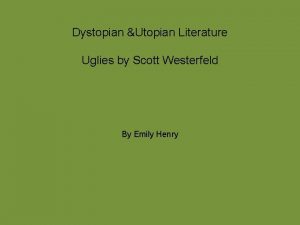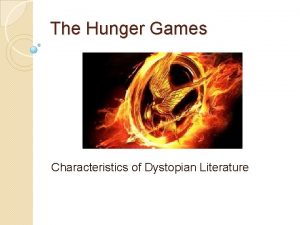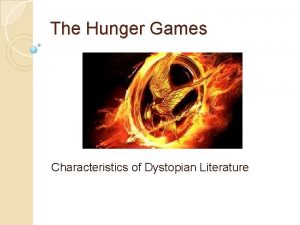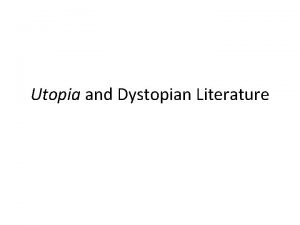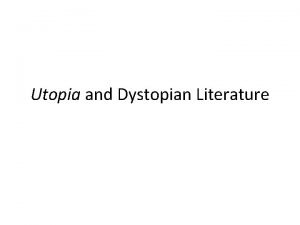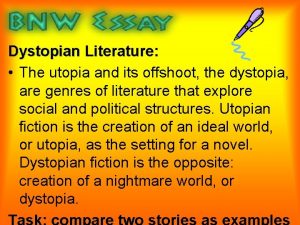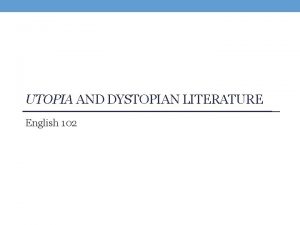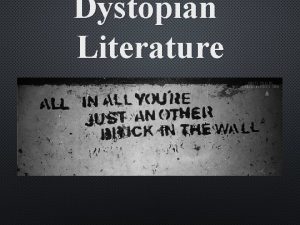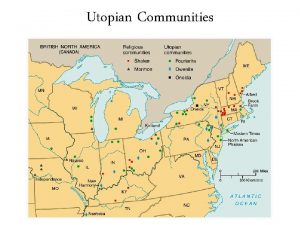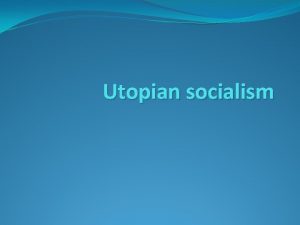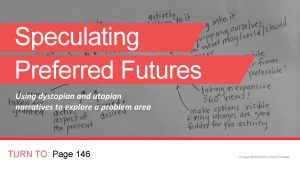UTOPIAN AND DYSTOPIAN LITERATURE Ms Clouse 2017 UTOPIA





























- Slides: 29

UTOPIAN AND DYSTOPIAN LITERATURE Ms. Clouse 2017

UTOPIA* Definition: A perfect society An ideally perfect place, especially in its social, political, and moral aspects Impractical Opposite of a dystopia

TYPES OF UTOPIAN SOCIETIES Ecological Utopia-an organic way of life, in harmony with nature. Economic Utopia-an equal distribution of goods and wealth. Citizens enjoy their work which is for the common good, leaving them ample time for the cultivation of arts and sciences. Political Utopia-World Peace, Global Onesness. A world without war.

TYPES OF UTOPIAN SOCIETIES Religious Utopia-Peace, Harmony, Understanding, Enlightenment Science and Technology Utopia-Set in the future. An absence of death and suffering; changes in human nature and the human condition.

BASIC POINTS OF UTOPIAN NOVEL*: The story is set in an isolated place The story is developed by following the principles of that place/society In the place/society there is a ruling class A tragic development occurs in contrast with what the reader expects

DYSTOPIA Definition*: An imaginary place or state in which the condition of life is extremely bad, as from deprivation, oppression, or terror. “dys”=Greek for bad, “topos” = Greek for place Opposite of a utopia

DYSTOPIA Often describes a society that starts off as a utopia or thinks it is a utopia but turns into an oppressive, miserable, dysfunctional state. Can serve as a cautionary tale or warning to modern day society

BASIC POINTS OF A DYSTOPIA* A hierarchical society where divisions between the upper, middle and lower classes are definitive and unbreakable (Caste system). The propaganda and the educational system have the purpose of preserving the order of system/society. The cancellation of individuality.

BASIC POINTS OF A DYSTOPIA* The constant surveillance by state police agencies More advanced technologies Back story of a disaster that justifies the dramatic social changes A protagonist that doubts the society

UTOPIA VS. DYSTOPIA Utopia Dystopia Society Equality of all people Classes, caste system View on future Optimistic, upbeat Pessimistic, downbeat Form of government Democracy Regime Education Equal and advancing education Propaganda Economy No money, equal distribution of goods Rich and poor people, no middle class Legislation Fair system of punishment Unfair and excessive punishment Atmosphere Happy, harmonic families Unfortunate, unlucky people

VARIETIES OF DYSTOPIA Society Social Groups Nature Politics Economics

SOCIETY Class System (Upper level Party members vs. Proles in 1984) People referred to as numbers rather than names People are cloned so there are several of the same people, they are uniform and lose individuality (Brave New World) People required to “not excel” and lose their competence

SOCIAL GROUPS Concept of Religion under attack (or the twisting of religion such as in The Handmaid’s Tale) Concept of families no longer exists (BNW and The Giver)

NATURE Examples: Settings of dystopias are frequently urban (Decaying London in 1984 and BNW) Separate all characters from any contact with nature People are conditioned to be afraid of nature (Babies and Plants/Books in BNW)

POLITICS Examples: Governing class is hedonistic or shallow Negative consequences, oppressive Pessimistic views of governing class – brutal, uncaring (Big Brother in 1984)

ECONOMICS Examples: Black markets for goods that are difficult to get (The Hunger Games, Antique Shop in 1984) Governing class controls everything Big businesses have control and are corrupt

COMMON CHARACTERISTICS OF A DYSTOPIAN SOCIETY* Information, independent thought, and freedom are restricted. Citizens may seem to be under constant surveillance. Citizens have a fear of the outside world. Citizens conform to uniform expectations. Individuality and disagreement are bad. The society is an illusion of a perfect utopian world.

THE DYSTOPIAN PROTAGONIST* Often feels trapped and is struggling to escape. (Winston 1984, John BNW, Montag Fahrenheit, Katniss HG) • Questions the existing social and political systems. • Believes or feels that something is terribly wrong with the society in which he or she lives. • Helps the audience recognize the negative aspects of the dystopian world through his or her perspective.

1984 Brave New World Author: George Orwell Aldous Huxley Historical Context Was a socialist writing against Totalitarianism as seen in the Nazi party and the Soviet Union. Was writing as a reaction to WWI and Fascism seen in the Soviet Union and gaining power in Europe. Written Scotland, June 1949 England, 1932 Period Late Modernism Narrator Third-person Omniscient Main Characters Winston Smith, The Dark Haired Girl (Julia), O’Brien, Mr. Charrington Bernard Marx, Helmholtz, John (the Savage), Lenina, Mustapha Mond, Linda Themes Totalitarianism/Communism, Individual/Collective, Reality Control, Sex, Love, and Loyalty, Class Struggle Dystopia and Totalitarianism, Technology and Control, the Cost of Happiness, Industrialism/Consumption, Individuality Symbols Big Brother The Glass paperweight The red-armed prole Ford Shakespeare


BRAVE NEW WORLD BNW is a dystopia—HUXLEY DOES NOT WANT THE SOCIETY IN BNW TO ACTUALLY HAPPEN He is satirizing the British society he was living in and criticizing their increasing emphasis on logic and disregarding emotions. This was a growing problem and idea seen in Hitler Germany during WWII.

CONTEXT FOR UTOPIA Written in 1516 by Sir Thomas More during the reign of Henry VIII of England. The word “Utopia” can be translated from the Greek as “Good Place” or “No Place, ” depending on which Greek letters are used. This ambiguity was intentional on More’s part. Utopia is social commentary, meant to contrast Tudor England under Henry VIII with the society of the Utopians. Social commentary was much more dangerous in Tudor England than it is today. This is one reason why More “frames” the narrative as a story he heard from a traveler he met who had supposedly visited Utopia.

UTOPIA AS SOCIAL It is generally agreed that More COMMENTARY did not mean to describe a “perfect” society in Utopia, but to use the “strange” traditions of the Utopians to spark discussion and criticism of real contemporary problems. More may not have meant to depict an ideal society; however, over the years the word “utopia” without the capital letter has come to mean “a perfect society” with an added connotation suggesting that such a society is unrealistic. A portrait of Thomas More by Hans Holbein

GROUP READINGS OF SECTIONS OF UTOPIA With your group, discuss the section of More’s Utopia that you were assigned and be ready report back to the class about what you learned. What unique features of Utopian society were discussed in your selection? What surprised you about your selection? What ideas about government and society did you find good or admirable? Which did you find questionable or problematic? Why?

FROM UTOPIA TO DYSTOPIA Dystopia: “An imaginary place where people lead dehumanized and often fearful lives. ” (From The Meriam Webster Encyclopedia of Literature) In contrast to “utopia, ” which can be translated “good place, ” “dystopia” is translated “bad place. ” Dystopian works of fiction often depict societies that claim to be advanced, civilized, and near-perfect, but are instead deeply flawed. Many protagonists in dystopian literature are individuals who begin to question the problematic rules and assumptions that pervade their societies.

SUGGESTIONS FOR APPROACHING A DYSTOPIAN NOVEL A if Know that focus on setting and world-building is often. AS as important not more important than character. READER Most dystopian novels are exercises in asking “what if, ” and authors use contemporary fears and concerns to build the societies in which their stories take place. Notice how individuals relate to their societies, and how the authors use current issues (such as the relationship between religion and government, or advancements in genetics and biology). Critic Thomas Moylan suggests that an experience reader of dystopian literature (or science fiction in general) “moves through the text like a traveler in a foreign culture or a detective seeking clues to unravel the mystery at hand. ”

CONTEXT FOR BRAVE NEW WORLD Written by Aldous Huxley, published in 1932. The title is taken from Shakespeare’s play The Tempest. The full quote is: “O wonder! How many goodly creatures are there! How beauteous mankind is! O brave new world! That has such people in it!” While 1984, another very influential dystopian novel, critiques Communist totalitarianism, Huxley is critiquing both Communism (many characters are named after Communist leaders) and capitalism (especially its tendency for consumerism) in this novel.

HENRY FORD AND THE MODEL T Henry Ford and his Model T, one of the first mass-produced cars, are both quite important to Brave New World. The calendar in the novel has Ford’s birth as its focal point, and the production of the Model T is a religiously significant event.

THE SCIENCE OF BRAVE NEW WORLD Though the science in the novel seems to be quite sinister, Huxley came from a family of scientists and believed very much in the potential of modern medicine and science. So, if the science in the novel seems to be frightening, ask yourself, is this a critique of scientific progress in general, or is it a critique of the uses to which science is being put?
 Characteristics of a utopian society
Characteristics of a utopian society Summary of part 3 of fahrenheit 451
Summary of part 3 of fahrenheit 451 Utopian vs dystopian
Utopian vs dystopian Perfect participle phrase
Perfect participle phrase Conditional future tense
Conditional future tense Dan clouse
Dan clouse Dystopia literary definition
Dystopia literary definition Dystopian genre characteristics
Dystopian genre characteristics Introduction to dystopian literature
Introduction to dystopian literature Archetypes in dystopian literature
Archetypes in dystopian literature Literature prefix
Literature prefix Name date period
Name date period Elementary data link protocols
Elementary data link protocols Karl
Karl Political utopia
Political utopia Francis ford selffinance 120m utopian
Francis ford selffinance 120m utopian Utopian simplex protocol
Utopian simplex protocol Utopia literary definition
Utopia literary definition Communism
Communism Eutopia vs utopia vs dystopia
Eutopia vs utopia vs dystopia Utopia and dystopia venn diagram
Utopia and dystopia venn diagram Syphogrants
Syphogrants What is dystopian fiction
What is dystopian fiction Utopia vs dystopia
Utopia vs dystopia Deasybib
Deasybib Utopia regressiva
Utopia regressiva Characteristics of utopia
Characteristics of utopia Describe utopia
Describe utopia Define distopia
Define distopia Paul utopia
Paul utopia
